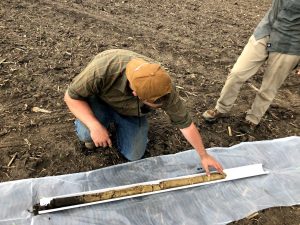Soil erosion factors and calculations
Amber Anderson
- Discuss factors influencing differences in rates of loss
- Estimate erosion loss under a given management scenario
- Predict how management changes could increase or decrease potential erosion losses
Estimating erosion
If the removal or deposit is clearly visible, as may be the case in gully, losses could be roughly estimated based upon the area removed. Generally, the losses are more subtle.

Estimating erosion after it has occurred, while may be needed to understand the extent of the damage and prevent future damage, is often too late.
Ideally, we would like to know the potential impact of a change before the erosion occurs. We use predictive models like the Universal Soil Loss Equation, or updated Revised Universal Soil Loss Equation (one or two) to predict the erosion under a given scenario. The major differences between these three equations is how conditions are calculated-with the first using one value for the year while updated equations divide up the year to recognize that conditions are not uniform throughout the year.
This equation only estimates rill and sheet erosion due to water.
[latex]A=R \times K \times LS \times C \times P[/latex]
Where:
A= estimated erosion in tons per acre per year
R=rainfall erosivity value
K=soil erodibility (between 0.05 for sandy soils and ~0.35-0.4 for more silty materials)
LS=slope factor accounting for both length and steepness
C=cropping factor
P=other practices
T="Tolerable" erosion
A note on T factor: This is set not at replacement rate, that is much smaller. It is what the soil could lose per year and maintain productivity for a medium term-it shouldn't be considered sustainable for long-term productivity.
- See the canvas assignment to walk through practice scenarios
- USLE is one tool to estimate losses anticipated (water erosion from sheet and rills) under a current or proposed management scenario

